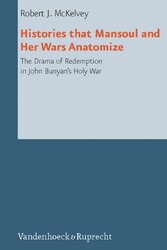Suchen und Finden
Service
Histories that Mansoul and Her Wars Anatomize - The Drama of Redemption in John Bunyan's Holy War
Robert J. McKelvey
Verlag Vandenhoeck & Ruprecht Unipress, 2011
ISBN 9783647569390 , 336 Seiten
Format PDF, OL
Kopierschutz Wasserzeichen
"4.3.2 The Theme of Warfaring (S. 184-185)
Turning from redemptive history to the literary theme of warfaring, the concept was by no means novel to Bunyan or seventeenth-century English thought. Roger Sharrock and James Forrest call attention to the fact that the above image “is very old and is commonly found associated with the general theme of the psychomachia or war between virtues and vices.”74 The literary theme of soul or virtue struggle dates back to the fourth century, though it finds its original source in Scripture.
The theme flourished in English works from the thirteenth to sixteenth centuries through the treatment of such topics as man depicted as a defended castle, human senses as the gates of the soul by which sin gains entrance, Christians in a city of unity besieged by Antichrist and his army, and the siege of virtues and the human soul. Arlette Zinck places The Holy War within the theological motif of psychomachy, which denotes a holy war within the individual soul or the inner conflict experienced in sanctification.
For the Reformers and Puritans in sixteenth and seventeenth-century England, psychomachy was “more than a theological concept”; it was a metaphor that dominated their daily lives.75 Zinck provides two broad similarities of the tracts giving instruction in the theme of warfaring: the illumination of “satanic wiles and stratagems” and instruction “in the use of spiritual defences or armours.”76
Sharrock argues that Bunyan was unaware of the history of psychomachy but had probably read The Isle of Man (1630). James B. Wharey was even more convinced: “That Bunyan was familiar with Bernard’s allegory, and that he was influenced by it, possibly in the Pilgrim’s Progress, certainly in the Holy War, scarcely admits of doubt.”77 Wharey points out at least the following similarities between The Isle of Man and The Holy War:
1. Bernard’s town of Manshire within the Isle of Man corresponding to Bunyan’s Mansoul within the country of Universe; 2. The heart as an Inn to the heart as a stately palace; 3. The five Inn-doors of Hearing, Seeing, Tasting, Smelling and Feeling to the Mansoul-gates of Ear-gate, Eye-gate, Mouth-gate, Nose-gate, and Feel-gate; 4. The character Wilful Will to Lord Willbewill; 5. The jailer New-man to the jailer True-man; 6. The chief constable Illuminated Understanding to the Lord Mayor Mr. Understanding; 7. Conscience, the judge of assizes to Conscience the recorder; and 8. The trial of Sin to the trial of the Diabolonians.78 In the end, the differences are greater than the similarities between the works. If Bunyan did indeed read the work, the greater impact beyond the similar names appears to be the trial scenes where abstractions are called to the bar and charged, examined, testified against, and indicted."

















